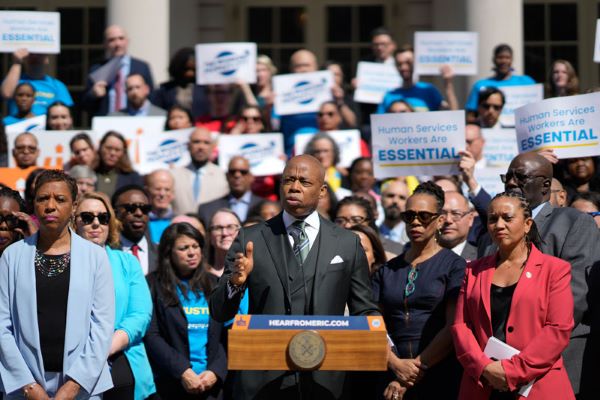NEW YORK – New York City Mayor Eric Adams announced a $741 million investment for an estimated 80,000 human services workers employed by non-profit organizations with a city contract as part of a new cost-of-living adjustment (COLA). The human services workforce — which is overwhelmingly female at 66 percent and 46 percent women of color — remains on the frontlines of the most pressing issues facing the city as they deliver vital services across housing, food access, health services, and asylum seeker services, among other areas.
The Adams administration’s investment in a new COLA represents a critical step towards delivering pay equity across race and gender for a workforce that provides lifesaving services across the city. With today’s announcement, to date, the administration has invested over $1.4 billion towards wage enhancements for the human services sector.
The agreement will offer 9.27 percent increase over next three years.
“When things get tough, we must invest in our most valued asset: the people who are on the frontlines solving the most pressing issues facing our city,” said Mayor Adams. “Human service workers are the hands and heart of New York City, providing 24/7 work that benefits all New Yorkers. From navigating our city during the darkest days of COVID-19 to caring for asylum seekers to tackling our homelessness crisis and so much more, human service work is often tiring and thankless, but the workforce is essential to our city. I am proud that our administration is delivering human services workers the pay raise they deserve, and putting money back into their pockets. By offering fair pay, we are creating a fairer and more equitable city, especially for this largely women and women of color population, and ensuring that New York City is not just the greatest city in the world to live, but also the greatest place to work, especially for those who sacrifice so much to serve others.”
“Our nonprofit partners in health and human services are the lifeblood and economic engine of our city, and tirelessly work in partnership with the city to support New Yorkers,” said First Deputy Mayor Sheena Wright. “This multi-year cost-of-living investment in our valued health and human services workforce is a crucial step for the sector. This work builds on the Adams administration’s commitment to equitably supporting our diverse workforce sectors across the city, to continue to clear the over $6 billion backlog of contract payments to our nonprofit providers we have already achieved, and provide direct relief to the more than 80,000 workers who serve our community every day.”
“Our human services workforce is comprised primarily of women, and specifically women of color. They are the underpinning of our not-for-profit workforce that complements and partners with New York City’s government in order to keep our city going,” said Chief Advisor to the Mayor Ingrid P. Lewis-Martin.
Building on a 7 percent workforce enhancement in the Fiscal Year 2024 Executive Budget, human services workers will see the following COLA:
- 3 percent effective July 1, 2024
- 3 percent effective July 1, 2025
- 3 percent effective July 1, 2026
Under Mayor Adams’ leadership, the city has made significant investments and enacted policies to support the human services workforce and put money back into the pockets of New Yorkers. The Adams administration worked with the Mayor’s Office of Contract Services (MOCS) on the the ‘Clear the Backlog’ initiative, now unlocking over $6 billion and allowing nonprofits to get paid for their vital services. Together with New York City Comptroller Brad Lander, MOCS, and the Mayor’s Office of Nonprofits, Mayor Adams announced a new reform for discretionary contracts that will eliminate red tape and make it easier for nonprofits that contract with the city to get paid on time. The innovative reform eliminates a total of nine months of discretionary, contracting processing time for nonprofits every year, beginning in the out-years for applicable contracts.



